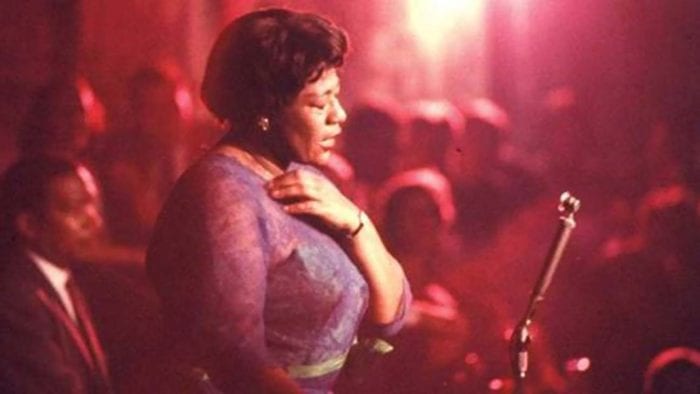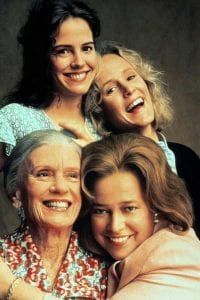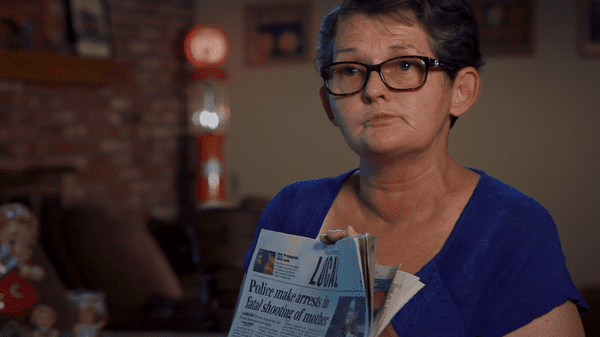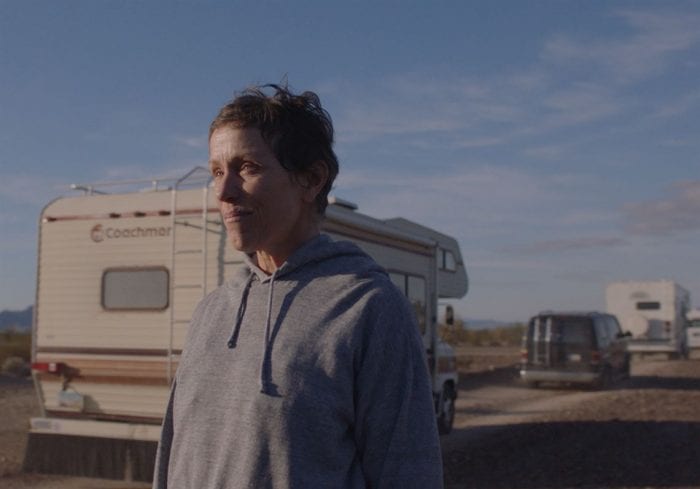Reviewed by Jeffrey Sanzel
Before there was Hamilton, Lin-Manuel Miranda burst onto the scene with the wholly personal In the Heights. A celebration of a largely Dominican community living in Washington Heights, Miranda provided music and lyrics and starred as Usnavi. The show was an instant hit with only minor carping on the book. The production ran from March 9, 2009, through January 9, 2011, for 1,184 performances.
The show received thirteen Tony Award nominations and won for Best Musical as well as Best Musical Score (Miranda), Best Choreographer (Andy Blankenbuehler), and Best Orchestrations (Alex Lacamoire and Bill Sherman). The original cast recording received a Grammy for Best Musical Show Album. Dozens of subsequent companies — including multiple productions in Spanish — have been seen in the Philippines, Panama, Japan, Brazil, Australia, Peru, Denmark, and many other places.
After a false start in November 2008 (with cancellation in 2011), it was announced in May 2016 that Miranda would co-produce the film with Harvey Weinstein. In the wake of Weinstein’s sexual misconduct charges, he was removed as the producer on the film, and Warner Bros. acquired the production.
The history of stage-to-screen musicals is an uneven one. For every Music Man and Sound of Music, there is an Annie or a Rent. Whether it is to one’s taste, Grease proved to be an enduring hit. Disasters have included Camelot, A Little Night Music, and Les Misérables. Genre connoisseurs argue the faults and merits of the cinematic incarnations of A Chorus Line and Into the Woods. Over the last few years, there has been a resurgence with mixed results: the brilliant reimagining of Chicago, the head-scratching Hairspray, the train wreck Cats. Being released this December is Stephen Spielberg’s much-anticipated remake of West Side Story.
It all comes down to whether the musical is making a joyous noise — or just making noise.
Does In the Heights live up to expectations? Oh, yes. That and much more. While it does not reinvent the genre, the film’s sheer exuberance is a celebration of both “a” community and this particular community.
The basic plot follows two couples. Usnavi, a bodega manager, pines for aspiring fashion designer Vanessa, who works in a local salon. Benny is a dispatcher in love with his boss’s daughter, Nina, who has just returned from Stanford, where she must confess that she dropped out. What follows is three days leading up to a blackout and its aftermath.
While Vanessa wants to move downtown, Usnavi struggles with a desire to rebuild his father’s restaurant in the Dominican Republic. Nina grapples with her experience in college and the events that led up to her return. In the Heights is equally a portrayal of the neighborhood — the connections, the gossip, the struggle, the pride — as it is the romance. If anything, the personal relationships are less engaging than the exploration of identity.
The film has departed from the Broadway production, adjusting multiple plot points for streamlining purposes. Some of the changes improve the narrative; others are less successful. Small cavils can be launched at the screenplay, which is serviceable but never rises to the level of the music and choreography. New issues — most notably that of the Dreamers — are introduced. Nina also speaks of a horrible racist experience she endured at Stanford. It is brought up and then dropped. If the writers choose to take on such important and complicated topics, the results deserve deeper exploration.
In addition, some of the scenes go on longer than necessary. (A dinner party meanders, never quite focusing.) “It Won’t Be Long Now”— one of the best numbers — is oddly broken up. The framing device of Usnavi telling the story in flashback seems to undermine the immediacy. But these are minor quibbles on what is pure joy.
John M. Chu directs the film with an eye for detail and an energetic but never rushed pace; the nearly two and a half hour running times flies. But it is Christopher Scott’s spectacular choreography that dominates. His work is bold, fearless, and epic, often encompassing hundreds of dancers. His dances will enter the annals of movie musical history (the climactic ballet in An American in Paris, the rooftop “America” in West Side Story, the barn-raising in Seven Brides for Seven Brothers, the opening to La La Land, just about any moment in Singin’ in the Rain, etc.)
The combination of old-fashioned musical theatre and contemporary style are perfectly blended. The title number sets the tone for the stunning production numbers to follow. Most notably are “No Me Diga” (a wryly hilarious and delightful number in the salon), “96,000” (a swimming pool blockbuster with more than a few shades of Busby Berkley), the haunting and jaw-dropping “Paciencia y Fe” (which will be referred to in perpetuity as “the subway song”), and the finale-like “Carnival del Barrio,” the celebrates rejoices at communities within communities. (Even the “small” numbers are equally impressive, especially Nina’s “Breathe.” Certainly, credit should be given to Chu, who knows when to pull back.)
The cast is uniformly excellent, all exceptionally effortless singers and dancers whose performances are grounded in truth. They make the transition from dialogue to singing seem natural, often something that feels disjointed or, worse, falls flat in the movies. Anthony Ramos delivers a heartfelt Usnavi, both anchor and core to the story. He is matched by Melissa Barrera’s strong but conflicted Vanessa. Corey Hawkins brings warmth and vulnerability to Benny. Leslie Grace’s Nina shows the strength and struggle of someone trying to both go forward in her life but honor her past. Her scenes with the gifted Jimmy Smits as her father are effectively complicated. (Smits shows a pleasant singing voice in his few vocal moments.)
Daphne Rubin-Vega (Broadway’s Mimi in Rent) finds humor and dimension in Daniela, the salon owner, who aspires for grander things. Olga Merediz, the only major holdover from the Broadway production, embodies matriarch “Abuela” Claudia with love and light. As Usanvi’s clerk Sonny, Gregory Dia IV easily mixes charm and “chutzpah” with a melancholic underpinning. Miranda is terrific as Piragüero, the Piragua Guy (shaved ice). While it is a small turn, his confrontation with the Mr. Softee vendor plays as the film’s cameo/Easter Egg highlight.
Usnavi speaks of sueñito — the idea of “little dreams.” The residents of this world all have them. But what comes through is that ultimately, they are not little. The dreams are big and powerful, honest and revelatory. In the Heights immerses the viewer in these hopes in a film that somehow manages to be both intimate and spectacular. This is the feel-good movie for which we have been waiting. While available on HBO Max, In the Heights is one of the best reasons to leave your couch behind and venture out to enjoy this bright shining jewel. Rated PG-13.

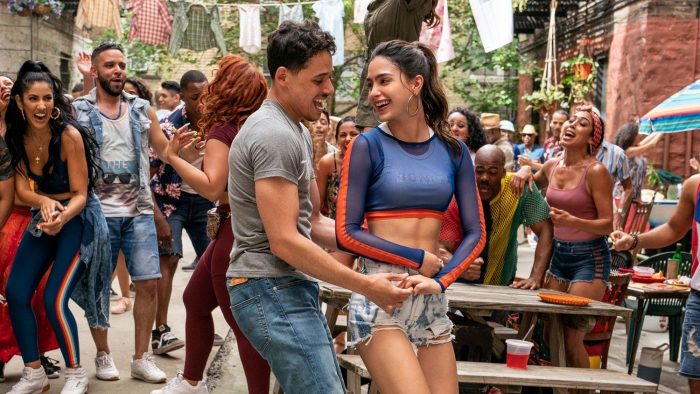
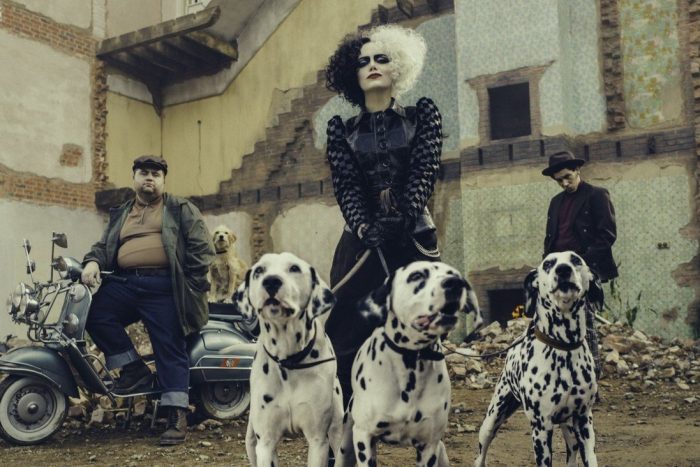
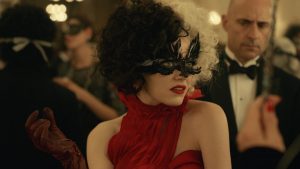
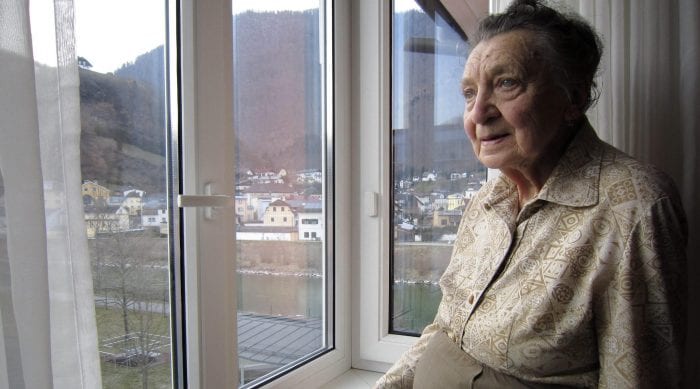



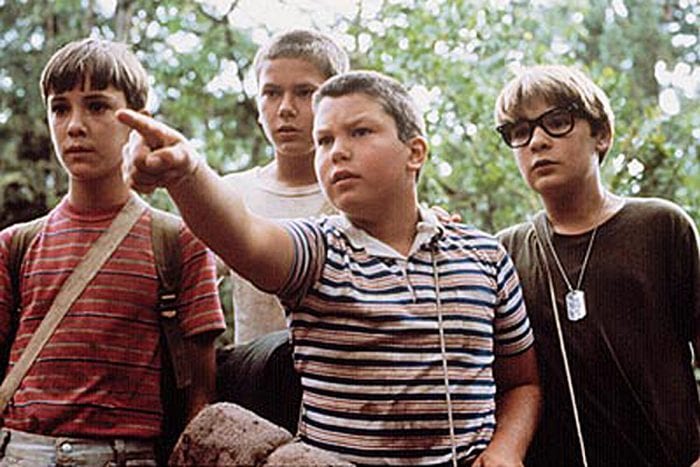
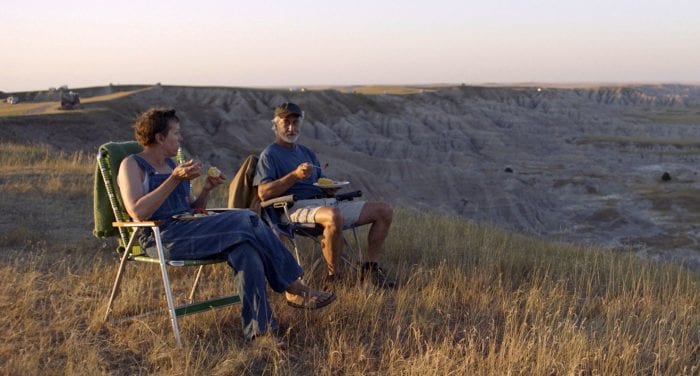
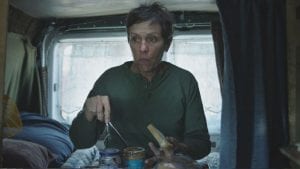 Fern (a brilliantly understated Frances McDormand) is a widow who, in 2011, lost her job at the US Gypsum plant in Empire, Nevada, when the factory shut down. The factory’s closing resulted in Empire becoming a ghost town. Fern has sold most of her belongings and lives in a van that she has retrofitted herself. She travels the country looking for work. The film opens with her at the Amazon fulfillment center, working a seasonal job.
Fern (a brilliantly understated Frances McDormand) is a widow who, in 2011, lost her job at the US Gypsum plant in Empire, Nevada, when the factory shut down. The factory’s closing resulted in Empire becoming a ghost town. Fern has sold most of her belongings and lives in a van that she has retrofitted herself. She travels the country looking for work. The film opens with her at the Amazon fulfillment center, working a seasonal job. There are glimpses into Fern’s earlier life, most notably a trip later in the film to borrow money from her sister, but, for the most part, the film focuses on the ever-present, day-to-day existence. This is a challenging undertaking for a filmmaker, but Zhao’s deliberate pacing and laser focus create both a pastoral arc and one of great tension. Fern drives, makes dinner on a hotplate, sleeps, then drives some more. She takes a job; she works; she leaves. She drives, humming to herself. She walks in nature, taking in its vastness but also completely at peace. And then she drives.
There are glimpses into Fern’s earlier life, most notably a trip later in the film to borrow money from her sister, but, for the most part, the film focuses on the ever-present, day-to-day existence. This is a challenging undertaking for a filmmaker, but Zhao’s deliberate pacing and laser focus create both a pastoral arc and one of great tension. Fern drives, makes dinner on a hotplate, sleeps, then drives some more. She takes a job; she works; she leaves. She drives, humming to herself. She walks in nature, taking in its vastness but also completely at peace. And then she drives. Eventually, Nomadland shows these travelers do not dwell in emptiness, but instead in lives of peace, away from the trappings and limitations of self-imposed restrictions. Fern meets Dave (kind and open as played by David Strathairn) at the gathering and then again later. There are the slightest of romantic sparks. Eventually, Dave settles at his son’s house, where Fern visits him. He asks her to stay, but she realizes that it is not the life she wants. Fern reveals she has found herself in this wandering existence. The revelation is presented in the simplest of ways, but it is epiphanous in its weight and import.
Eventually, Nomadland shows these travelers do not dwell in emptiness, but instead in lives of peace, away from the trappings and limitations of self-imposed restrictions. Fern meets Dave (kind and open as played by David Strathairn) at the gathering and then again later. There are the slightest of romantic sparks. Eventually, Dave settles at his son’s house, where Fern visits him. He asks her to stay, but she realizes that it is not the life she wants. Fern reveals she has found herself in this wandering existence. The revelation is presented in the simplest of ways, but it is epiphanous in its weight and import.